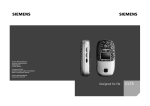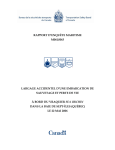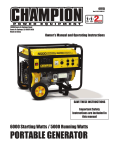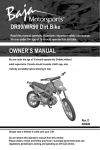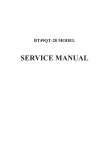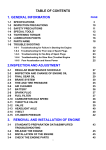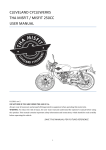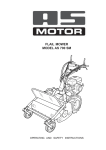Download oliver 50cc scooter owners manual
Transcript
Page 1 from 37 Dear customers! First of all thank you for buying a vehicle from our company. Before starting to ride your new vehicle, we recommend to read this user guide very careful. It contains a lot of important information and advices for the correct use. This user guide is one part of the equipment of the vehicle and at the sale it must be handed over to the owner. We reserve the right to make technical modifications on the vehicles without changing the characteristic features of them. We are not responsible for mistakes in the translation or the printing of the user guide. If you have any questions, please contact one of our authorized dealers. We wish you a lot of fun and a good start with your new vehicle. Page 2 from 37 Index 1. General information 1.1 Prior starting vehicle 1.2 Modifications on the vehicle 1.3 Important code numbers on the vehicle 6. How to stop and park 6.1 Stop 6.2 Parking 6.3 Choice of a suitable parking place 2. Parts location 3. Various parts operation 3.1 Dashboard 3.1.1 Speedometer 3.1.2 Odometer 3.1.3 Oil level indicator 3.1.4 High beam indicator 3.1.5 Direction light indicator 3.1.6 Fuel indicator 3.1.7 Current time function 3.2 Ignition lock 3.3 Starter button 3.4 Headlight switch 3.5 Dimmer switch 3.6 Horn 3.7 Direction indicator 3.8 Steering lock 3.8.1 Locking 3.8.2 Unlocking 3.9 Helmet box 4. Starting engine 4.1 Starting the engine with electricity 4.2 Kickstarter 5. Correct riding operation 5.1 Start up 5.2 Speed adjustment 5.2.1 Acceleration 5.2.2 Deceleration 5.3 Running in instructions 5.4 Correct braking and turning 5.5 Riding when it rains 5.6 Safety through training 7. Inspections before operation 7.1 Fuel 7.2 Steering 7.3 Brakes 7.3.1 Drum brake 7.3.2 Disc brake 7.4 Stop light 7.5 Direction indicator 7.6 Tires 7.7 Shock absorber 7.8 Illumination 7.9 Horn 7.10 Speedometer 7.11 Back mirror 8. Regular maintenance and inspection 8.1 Battery 8.1.1 Removal and assembly of battery 8.2 Fuse 8.3 Bulb replacement 8.3.1 Head light 8.3.2 Direction indicator front and rear 8.3.3 Tail and stop light 8.4 Correct adjustment of low beam 8.5 Inspection of cable rubber parts 9. If engine does not start 10. Safety operation 11. Final thought 12. Technical data 13. Service instructions Page 3 from 37 1. General ínformation 1.1 PRIOR STARTING VEHICLE This manual describes matters pertaining to correct operation, safe operation and simple maintenance of the vehicle you purchased. To ensure more comfortable and safer operation, we recommend to read this manual carefully prior to operation. • • • • • • The photographs and pictures shown in this manual may differ from those of actual vehicles due to changes in vehicle specifications or made modifications. This vehicle is designed for 2 riders including the operator. If you use the vehicle in an irregular way, you aren’t eligible for any warranty claim. Check the vehicle before your first trip. Keep the vehicle clean and conduct all specified maintenance inspections. Make sure to stop engine and stay away from fire when refuelling. Exhaust gas contains harmful substances such as carbon monoxide. Start engine at wellventilated places. 1.2 MODIFICATIONS ON THE VEHICLE All modifications on the vehicle, as the increase of cylinder capacity, the engine output or speed, change the characteristic features of the vehicle category. Additional this is prohibited by law and will be prosecuted. If you ride without any driving license you take a risk that your vehicle will be confiscated and must be checked and admitted again through the appropriate authority. Also note, that all modifications regarding the exhaust emission characteristics and noise behaviour cause the expiry of the driving license. Furthermore all modifications at illuminiation, license plate, license plate holder, acustic warning devices or back mirrors are not allowed by law and you haven’t an insurance coverage anymore. Pay attention that all above mentioned modifications are not covered by warranty and releases the manufacturer from any liability. Use only genuine parts respectively parts which are recommended from the manufacturer or authorized dealer. The dealers offer a wide range of accessories which conform to any technical, functional and aesthetic features of the vehicle and comply to the road traffic regulations. The fitting of not original accessories, as wind shield, top case may affect your riding safety and is possibly subject to authorisation. The use of accessories or spare parts not released through the vehicle manufacturer could cause the expiry of any warranty claim. Attachment • Do not add electrical equipment (radio, illumination) - that will exceed the vehicle’s electrical system capacity. Page 4 from 37 1.3 IMPORTANT CODE NUMBERS ON THE VEHICLE The vehicle has following code numbers: – vehicle identification number – engine number – license plate Record the vehicle identification number and the engine number along with the vehicle license plate number and keep them separately from the vehicle. Any modification of the VIN is not allowed. Before licence of the vehicle, it is important to compare the VIN on your vehicle with the VIN mentioned in your vehicle documents. Vehicle identification number: The VIN (17-digit) is important for its explicit identification and is needed for registration at the responsible authority. It is stamped on the frame as you can see on the picture. Engine number The serial number of the engine is stamped on the top of the lh crank case. Page 5 from 37 2. PARTS LOCATION OLIVER CITY Back mirror Type plate Anti tampering plate (under the seat) Luggage holder Tail/stop light Seat lock VIN Engine number Battery Side stand Air filter Kickstarter Brake lever for rear wheel Helmet box Brake lever for front wheel Fuel tank Direction indicator Ignition lock Luggage carrier Head light Direction indicator Exhaust Oil tank Main stand Page 6 from 37 OLIVER SPORT Back mirror Type plate Anti tampering plate (under seat) Tail/stop light Luggage holder Seat lock VIN Engine number Battery Air filter Kickstarter Side stand Brake lever for rear wheel Fuel tank cap Brake lever for front wheel Helmet box Direction indicator Ignition lock Luggage carrier Head light Direction indicator Exhaust Oil tank Main stand Page 7 from 37 3. Various parts operation 3.1 DASHBOARD Oil indicator Odometer Direction light indicator Fuel level indicator Speedometer Time High beam indicator 3.1.1 Speedometer • The standard speed indication is km/h. 3.1.2 Odometer • Total forward distance is indicated in km. The white digits on black background indicate 100- m-units. 3.1.3 Oil level indicator • If the oil level drops below the MIN-marking in the oil tank, the oil indicator is lighting on the display. Stop your vehicle immediately and fill up engine oil of specification mentioned in the maintenance schedule. • After changing oil and turning the key to “ON”, the oil level indicator has to go out. Check the function of the oil level indicator by turning the ignition key to the position between “ON” and “OFF”. In this position the oil level indicator has to light up. Generally we recommend to check a satisfactory oil level always when you fuel the vehicle. 3.1.4 High beam indicator • When operating the high beam indicator the symbol for high beam is lighting on the display. 3.1.5 Direction light indicator • When operating the left or right direction indicator, the relative symbol for the left- or right hand side is blinking on the display. 3.1.6 Fuel indicator • It indicates the fuel volume in the fuel tank. If the fuel level reaches the reserve fuel area, the fuel indicator is lighting on the display. Refuel as soon as possible. 3.1.7 Time • The time will be indicated in hours and minutes. Page 8 from 37 • Through pressing the rh mode-button the date will be indicated for about 4 sec. • Through shortly pressing the lh mode-button the date and the time appear alternately. • Through pressing the rh mode-button twice, the seconds will be indicated on the display. To reset, press the lh mode-button twice. Through pressing the rh mode-button the adjustment will be confirmed and the time will be indicated on the display. • Through pressing the lh mode-button twice, the month will be indicated. Adjustment through pressing the rh mode-button, confirmation through pressing the lh mode-button. The display indicates the day – adjustment through pressing the rh mode-button and confirmation through pressing the lh modebutton. • The display indicates the hours – adjustment through pressing the rh mode-button and confirmation through pressing the lh mode-button. The display indicates the minutes – adjustment through pressing the rh mode-button, confirmation through pressing the lh mode-button. • Through pressing the rh mode-button the adjusted time now will be indicated on the display. 3.2 IGNITION LOCK Due to the ignition lock it’s possible to start or stop the engine. The ignition lock is placed below the operating elements. Off • • On The electric circuit of the vehicle is intermitted, the engine cannot be started. Key can be placed in or taken out of the ignition lock. Page 9 from 37 • • The electric circuit of the vehicle is connected, the engine can be started. Key cannot be pulled out. Lock • • The electric circuit of the vehicle is intermitted, the engine cannot be started and the steering is locked. Key can be placed in or taken out of the ignition lock. Never operate the ignition key during travel as it might cause unexpected accidents. If it is necessary to remove the ignition key, stop the vehicle. 3.3 STARTER BUTTON • The starter button is placed next to the throttle grip. Due to pressing the starter button and pulling the brake lever, the engine can be started (ignition key must placed to “ON” position). (See „starting off engine“, chapter 4). Do not press the starter button longer than 4 sec., as the starting motor consumes a lot of electricity and this discharges the battery. Page 10 from 37 3.4 HEADLIGHT SWITCH Off • Light switched off Parking light • Parking light, dashboard light and tail light are turned on. Driving light • Driving light turns on. Page 11 from 37 3.5 DIMMER SWITCH 1. High beam In this position the high beam is turned on. 2. Low beam In this position the low beam is turned on. 3. Headlamp flasher Through keep pressing the high- and low beam switch the high beam is lighting. • Use the high beam only in the suburban. Take care to the other road users when using the high beam! 3.6 HORN • The horn sounds if the horn button is pressed and the ignition key is in “ON” position. h Page 12 from 37 3.7 DIRECTION INDICATOR To activate the direction indicator, you have to turn the ignition key to “ON” position. Depending in which direction you want to ride, you have to press the button into the left or right position. To switch off the direction indicator, press the button. • • • • You have to use the direction indicator while turning or changing lines and if necessary when you start or stop to ride. If the direction indicator is used, this will be signalized through the direction light indicator on the dashboard. The direction indicator does not stop automatically. You have to stop it manual through pushing the button. Please note, that you can endanger other road users and yourself if you don’t switch off the direction indicator after turning. The direction indicator does only work when the ignition key is in “ON” position. 3.8 STEERING LOCK • When parking, make sure to lock steering to prevent theft of the vehicle. 3.8.1 Locking • Turn the steering to the left, push the ignition key soft and turn it at the same time into the LOCK position. Take off the ignition key. 3.8.2 Unlocking • Turn the ignition key clockwise and move the steering handle lightly in both directions. Page 13 from 37 • • • Check to see if the steering has been securely locked by lightly moving the steering to the left and right hand side. Make sure to park the vehicle in a safe and suitable location. Never operate the ignition key during travel as it might cause unexpected accidents. 3.9 HELMET BOX • There is a helmet box under the seat. Do not store any important documents in the helmet box. Reasons: - potential theft - water could enter the luggage compartment during washing the vehicle The helmet box can be opened through turning the ignition key in the helmet box lock. Note, that the helmet box closes automatically when you shut the cover. • • • • • • Make sure that the seat is securely locked after closing the seat. An unlocked seat can affect your riding safety. The temperature inside the helmet box rises due to the heat from the engine. Do not place foodstuffs and other articles that can be damaged easily by heat. Do not place valuable or fragile goods in the helmet box. Note that water can enter the helmet box when washing the vehicle. Do not load stuff more than 3 kg. 4. Starting the engine • • • The exhaust gas contains poisonous carbon monoxide gas. Never start the engine in closed areas. When you start the engine you have always to pull the rear wheel brake. It’s important for your own safety and to avoid a jerky start of the vehicle. Do not let run the engine at idle speed – danger of overheating! Avoid full throttle after cold start! Page 14 from 37 4.1 STARTING THE ENGINE WITH ELECTRICITY 1. 2. 3. 4. 5. Put the vehicle on the main stand Checkup of oil- and fuel level Pull the rear wheel brake Turn the ignition key to „ON“ position Press the starter button without turning the throttle grip • • • • Immediately release the starter button as soon as the vehicle has started. Do not press the starter button when the engine is running. This can damage the starter motor. Do not keep the starter button pressed for more than 4 sec. Release the starter button for approximately 30 sec. before pressing it again. If the engine is hot and doesn’t start after pressing the starter button for 3 – 4 sec., turn the throttle grip to 1/8 ~ ¼ of a rotation and try again (after 30 sec.). Page 15 from 37 • It is possible that starting will be more difficult if the vehicle has not been used for a long time. In this case, push the starter button a few times without turning the throttle grip. • If the engine did not start after pushing the starter button for approximately 4 sec., wait about 30 sec. before trying it again. This waiting period is important for the regeneration of the battery. • If the engine is cold, the engine should warm up at idle speed. • If the electric start does not work or if the battery is empty, you can start the engine also by using the kickstarter. 4.2 KICKSTARTER • Don’t turn the throttle grip, pass through kickstarter pedal strongly to start the engine. • Do not operate the kickstarter, if the engine is running. 5. Correct riding operation • • Roll off the vehicle from the main stand. During this operation pull the rear brake to avoid an unexpected start. Get on the vehicle. If you are ready to start, loose the brake lever and turn the throttle grip slowly to move the vehicle. • • Do not turn on the throttle grip quickly, to prevent an unexpected break out of the vehicle. Note that it should be avoided to sit on the vehicle during the main- side stand is clicked off – danger of breakage. Page 16 from 37 5.1 START UP • Pay attention to the traffic around you before start riding and use the direction indicators if necessary. 5.2 SPEED ADJUSTMENT The speed is always dependent on the position of the throttle grip. 5.2.1 Acceleration • The speed of the vehicle increases due to turning the throttle grip against the driving direction. When climbing a hill, the throttle grip needs to be turned stronger to give the vehicle more power. 5.2.2 Deceleration • The speed decreases due to turning the throttle grip in driving direction. • A quick rotating of the throttle grip will cause the vehicle to move forward suddenly! 5.3 RUNNING-IN INSTRUCTIONS An initial break-in phase of the engine ensures optimum service life and performance of the engine. Therefore note following proposals: • • • • • Maximum engine speed during the first 1000 km should not exceed 40 km/h, also avoid continuous full load. Avoid sudden acceleration, to increase the durability of the engine. Do not operate the engine at high revolutions without loading (for example at full throttle on the main stand) New tires have a smooth surface. It is necessary to roughen the tires through careful running-in. In this way the contact surface of the tires will receive their full adhesion. Additional it’s important to break-in new brake pads. Pay attention that new brake pads do not have their full friction force during the first 500 km. The braking effort can be improved due to pulling the brake levers stronger. Avoid any hard stops at this period. Safety regulations during riding • • • • • Always pay attention to have enough safety distance to other road users Ride defensive Do not hinder other road users Do not ride on side walks Always ride in a way to be able to stop your vehicle immediately Page 17 from 37 5.4 CORRECT BRAKING AND TURNING Brake lever for rear wheel • • • Brake lever for front wheel Sudden braking or turning can cause the vehicle to slide and tip over. After returning the throttle grip to its original position, apply front and rear brake together. The most effective way to brake, is to operate the brakes first lightly and then change to a more firm squeeze. • • • You have to pull front- and rear brake always together. Sudden and hard brake maneuver can cause an accident! Note that the braking distance extends a lot when you just use one brake! 5.5 RIDING WHEN IT RAINS • • • • More braking distance is needed when riding on wet roads. Reduce speed and be sure to initiate the braking operation sooner than when riding at normal conditions. While riding downhill, turn the throttle grip back to its initial position to reduce speed, apply the brakes and ride slowly down the hill. It’s possible that the brakes temporarily loose their proper braking effort after a ride in the rain. To ensure that the brakes are operating properly, slow down and lightly apply the brakes to rid the brakes of any excess water and to dry them. If possible, avoid to ride at snow or on icy roads. 5.6 SAFETY THROUGH TRAINING • – – Get a feeling for dangerous situations. This means, think of potential hazards and don’t trust in the correct riding of other road users. It’s important to ride through curves rhythmical without any hard stops or full throttle. Reduce the speed accurately when you ride into a curve – safety is more important than high speed! Page 18 from 37 – • • – You have to look ahead along the inner side of the planed lane, so that you can see early enough the exit of the corner. Consider the reaction time when you brake. Train with and without passenger the reaction of the brake on different road lengths. Find out carefully when the tires block. 6. HOW TO STOP AND PARK 6.1 STOP • • Turn on the direction indicator timely and take care of vehicles behind you. Return the throttle grip back in it’s original position and apply the front- and rear brake together. The stop light will lighten and alert vehicles behind of you that you are stopping. 6.2 PARKING • After stopping the vehicle, switch off the direction indicator and turn the ignition key to “OFF” position, to stop the engine. • Never operate the ignition key during riding the vehicle, as it might cause an accident. 6.3 CHOICE OF A SUITABLE PARKING PLACE • • • • Be sure to park in an area that is free of traffic. Pay attention that you park your vehicle on a firm, level ground. Put the vehicle on its main- or side stand. To park the vehicle, hold the steering with the left hand and click down the main stand with the right foot. To prevent stealing, lock the steering while parking and pull out the ignition key. • • Always park your vehicle in a safe area that is free of traffic. Pay attention to the hot engine and exhaust system! 7. Self inspections before operation Check the vehicle and have regular maintenance inspections for increased safety and prevention of accidents. If you find any malfunction during inspection or anything seems to be abnormal, contact one of our authorized dealers for inspection and repair. Prior operating the vehicle, always perform following checkups: Checkup of the security relevant components: • Fuel level • Tires • Brakes, brake fluid • Engine oil level Page 19 from 37 • • • • Electrical system, illumination Back mirrors Checkup of brake hose and connections if they are damaged or untight. License plate (dirt, crack) 7.1 FUEL • Turn the ignition key to „ON“ position. If the fuel level reaches the reserve fuel area, the fuel indicator is lighting on the display. Refuel as soon as possible. Reserve fuel capacity: ~ 1l REFUELLING Engine must be stopped during refuelling. Turn the ignition key in the fuel tank lock rightwards to open it. • • Do not overfill the tank. Fuel may leak out of the fuel tank due to fuel expands when it becomes warm. It must be used unleaded fuel 91 ROZ – leaded fuel does disturb the catalyst. • • If oil or water enters the fuel tank, the vehicle may not be started! If the fuel is leaked by rupture of the fuel hose, fire can be the result. Accordingly check if the fuel hose is leaking. Page 20 from 37 • Fuel is extremely flammable and explosive under certain conditions. Do not handle with fire in the near of the fuel tank. 7.2 STEERING • • Check the steering by moving it to the left and right hand side. Sit down on the vehicle, pull the front wheel brake and push respectively pull the vehicle forward and backward. At these actions no clearance of the front suspension must be hearable or noticeable. It must be possible to move the steering evenly and without resistance from the left to the right hand side. Pay attention to any abnormal noise. • If you feel any resistance or something seems to be abnormal, contact one of our authorized dealers for inspection and repair. 7.3 BRAKES 7.3.1 Drum brake (rear) • The free play of brake lever has to be properly adjusted. The correct free play is about 1 – 2 cm. Free play means the distance between loose and tight position of brake lever. • Always check the free play at the brake lever. If necessary adjust it. Rear wheel brake adjustment (drum brake) reduces free play • • increases free play After brake adjustment, match the concavity of adjusting nut with axle pin to prevent the danger resulting from the change of free play during riding. Ride the vehicle on a short distance to make sure the retarding effort. Page 21 from 37 7.3.2 Disc brake (front) Check-up of brake fluid • You have to turn the steering thus the brake fluid is level in the reservoir. • The brake fluid level must not drop below the “MIN” marking • If the bake fluid is significantly lower than the specified level, check the brake pads for wear. lf the brake pads are ok, also the braking system must be inspected. • If the brake pads are worn out, let them change through an authorized dealer. Inspection glass • • If brake fluid level is exceedingly low, it can be a sign for a defect of the brake system. A leak in the brake system can lead to reduce the braking efficiency and possible loss of retarding effort. To ensure the operating safety of the brake system, all works have to be done by one of our authorized dealer! Wet brakes After washing the vehicle or during riding in the rain, the retarding effort could be delayed due to wet or in winter iced-up brake discs and brake pads. • The brakes must be braked dry! Salt on the brakes It is also possible that the retarding effort is delayed when you ride on roads covered with salt. • • The salt on the brake discs and brake pads must be grinded off during braking! Pay attention that brake discs and brake pads also must be free of oil and grease! Dirty brakes At trips on dirty roads, the retarding effort could be delayed as the brake discs and brake pads are dirty. • The brakes must be braked clean! Increased wear through dirty brakes! Page 22 from 37 7.4 STOP LIGHT • • • Turn the ignition key to „ON“. While separately operating the front and rear wheel brake, check if the brake light turns on. Also check if there is any damage to the lens or if there is dirt on the brake light. 7.5 DIRECTION INDICATOR • • • Turn the ignition key to „ON“. Operate the direction indicator for both directions and check if they are flashing properly. Check also if any of the lens are damaged or dirty. 7.6 TIRES Air pressure • Check the tire pressure just at cooled off tires. • We recommend to check the tire pressure by using a pressure gauge regularly. • If no pressure gauge is available, you have to check the tire pressure by examining how the tire sits on the ground. Correct tire pressure 12“ tires Front Rear Front Air pressure Rear Tire size 120/70-12 130/70-12 1,9 bar 2,0 bar Page 23 from 37 • • • • Not correct tire pressure causes abnormal wear and an insecure vehicle handling! Check tire tread and sides for nails, rocks etc., that might have become wedged in the tire. Check tire tread and sides for cracks and damage. Check-up of tread depth – recommendation 2 mm at all areas of the tire (pay attention to the demanded minimum tread depth). • • • If there is any crack or wear exceeding the limit, replace the tire at once! After replacing the tires, check the reaction of the brakes at a safe area without traffic! The main reason of going crack, unstable handling and abnormal abrasion is a wrong tire pressure (too high or too low). 7.7 SHOCK ABSORBER • • • Apply the front wheel brake and swing the vehicle up and down while adding your weight on the steering, to check if the front shock absorber works well. To check the function of the rear suspension strut, you have to move the vehicle up and down with your weight in the back area. Check the tightness of the shock absorber. • If the shock absorber or the suspension strut does not work correctly or if you found out a leakiness, you have to contact an authorized dealer immediately. 7.8 ILLUMINATION • • • • Turn the ignition key to „ON“. Operate the headlight switch to see if the light turns on. Check all lights if they are dirty or damaged. Check the correct adjustment of the headlight. The light of the low beam must shine 1% in direction to the road surface. If you are not sure if your headlight has the correct adjustment, contact one of our authorized dealers for check-up! 7.9 HORN • Turn the ignition key to „ON“ and press the horn switch button to check if the horn sounds. Page 24 from 37 7.10 SPEEDOMETER • • • • Check the speedometer spindle for damages regularly. Ensure sufficient lubrication of speedometer gear. Do not wash the vehicle with high pressure to avoid that what can enter. Check the correct function of the speedometer when you start to ride. 7.11 BACK MIRROR • Sit down on the vehicle and check the correct adjustment of the back mirrors as well if they are dirty or damaged. 8. Regular maintenance and inspection For safe and smooth riding regularly maintenance and inspections are absolutely necessary. Our authorized dealers provide after-sales service, maintenance and repair for you. Consider, that in the owner manual you’ll just find a few points of maintenance. Also the attached emergency tool is suitable for small repair works. To be able to make a proper inspection it’s important to have a special training as well you need suitable tools. Additional all screws must be checked for the correct assembling torque. Therefore we recommend to do repairs by yourself just in emergency cases but anyway accordingly contact your authorized dealer for check-up. Permanent high speed operation, or operation in unusual wet or dusty conditions, will require more frequent service than specified in the maintenance schedule. SAFETEY INSTRUCTIONS: • • • Make sure that the vehicle stands on smooth, level ground on it’s main stand! The engine must be off and the ignition key must be pulled out at any repair works. Pay attention to the hot exhaust system after stopping the vehicle! 8.1 BATTERY Maintenance-free battery (M/F) This vehicle is equipped with a maintenace-free battery. It’s not necessary to check the battery electrolyte level or add distilled water – do never remove the battery cap! 8.1.1. Removal and assembly of battery 1. 2. 3. 4. The battery is placed in the recess of the floor panel. Remove the cap of the floor panel through loosen the screws. Make sure that the ignition is switched off, when you connect or disconnect the battery cables. Disconnect the negative (-) terminal lead from the battery first, then disconnect the positive (+) terminal lead. Consider the correct order to avoid a short circuit! 5. If the battery terminals are polluted or in rust, separate battery and clean them, if necessary lubricate them with special grease. • • Stay away with all flammable materials during handling with battery. Batteries give off explosive gases. Make sure that the terminals do not contact other adjacent parts. Contact with other parts may cause a malfunction of electrical system, fire or an electric shock! Page 25 from 37 • • Wear safety goggles and protective gloves always during works at the battery! The charging of the battery has to be done exclusively from an authorized dealer! • When not using the vehicle for a long time, the battery discharges and must be full charged at the next trip with the vehicle (authorized dealer). When not using the vehicle for a long time, we recommend to take off the battery and to store it in full charged condition on a well ventilated place. Otherwise it could result in a durable damage of the battery. Proper charging and storage increases the durability of the battery. • • 8.2 FUSE If the electrical equipment doesn’t work after turning the ignition key to „ON“ position, check the fuse. • • • The fuse is placed near the battery. Remove the cover of fuse box and take out the fuse. Check-up of fuse, if necessary replace it. Pay attention that the fuse fits proper as well that the contacts are clean and dry. • • • • • • Always use the recommended fuse. Using different fuses may cause cable fire! When replacing any of the electrical parts, be sure to replace them with genuine parts. Using different parts can lead to the fuse burning out or damage to the battery. If a short circuit was the reason for a defect fuse, you have to consult an authorized dealer. Always switch off the ignition before you replace the fuse! Defect fuses must be exchanged. No repair of defective fuses – fire hazard! Carry along reserve fuses! Do not wash your vehicle with high pressure water. 8.3 BULB REPLACEMENT • • • Be sure to turn the ignition to „OFF“ position when replacing bulbs. Generally you have to be careful at handling with electrical components and cables. Do not touch the bulbs with your fingers as they must absolutely be free of grease! Wear clean gloves while replacing bulbs. Pay attention to proper electric contacts! Page 26 from 37 The vehicle is equipped each with a lamp for low- and high beam, parking light and additional for stop light and tail light. 8.3.1 Head light 1. Turn the ignition key to „OFF“ position. 2. Remove the front cover by using a suitable screw driver. Loosen the connector. 3. Take out the bulb and replace it. ATTENTION – touch bulb exclusively on the socket – it must be free of grease! 4. Assembling in reverse order. • • At the removal of plastic parts, pay attention that they won’t be scratched. Additional you have to attend to connection clamps so that they won’t be damaged. In case of doubt contact one of our authorized dealer. Pay attention to the correct fixing of the bulb to ensure its function. The plastic ring must snap in and the bulb must be fixed in the correct position. 8.3.2 Front and rear direction indicator 1. Turn the ignition key to „OFF“ position. 2. Remove the two indicator lens carefully (transparent and orange) by using a suitable screwdriver. 3. Through lightly pulling, the bulb can be removed. 4. Assembling in reverse order. 8.3.3 Tail- stop light 1. Remove the taillight housing carefully. 2. Press and turn to the left to take out the bulb. 3. Assembling in opposite succession. 8.4 CORRECT ADJUSTMENT OF LOW BEAM The correct adjustment of the low beam is important for your own safety as well for the safety of all other road users. When buying the vehicle, the head light is already correct adjusted. To check or adjust the head light you have to consult an authorized dealer. If the normal load conditions of the vehicle change, the head light adjustment has to be adapted. 8.5 INSPECTION OF CABLE RUBBER PARTS For protection of the inner cable there are assembled rubber bushings on the cables. Make sure that the rubber bushing is placed firmly around the cable. When washing the vehicle, do not directly spray water on the rubber part. Use a dry cloth to clean this area. Page 27 from 37 • • According to the maintenance schedule the rubber bushings must be checked and lubricated regularly! Avoid access water as it could cause corrosion and water freeze in the winter. 9. If engine does not start . . . • • • • • Check the fuel level. Try to start the vehicle by operating the kickstarter. Check the spark plug. Battery discharged? If the vehicle nevertheless couldn’t be started consult an authorized dealer for inspection. 10. Safety operation • • We recommend to consult your workshop frequently allthough your vehicle is may out of warranty. This is the best way to ensure that your vehcile is well maintained and everything is working well. Your dealer knows your vehicle well and is able to find out little mistakes on time whereby big difficulties could be avoided in advance. In this way you can save time and money. 11. Final thought That can you do for your vehicle: • • • • • Regularly maintenance and check up of all functions before start riding. If possible avoid a direct and long-term insolation of the vehicle (damages of the varnish, head light). Maintenance of your vehicle through specialized staff of your dealer. Use only original accessories. It complies to all safety regulations as well it is adjusted especially for your vehicle. Do not fit non licensed accessories. You take the risk to loose insurance coverage and your driving license. Page 28 from 37 12. Technical data Type of engine Cooling system Lubrication system Bore / Stroke Cylinder capacity Compression ratio Nominal power Nominal torque Fuel tank max. capacity Sort of fuel Stroke of front suspension Stroke of rear suspension Brake front Brake rear Rim size front Rim size rear Tire size front Tire size rear Transmission primary ratio (R1) Transmission secundary ratio (R2) Transmission final drive ratio (R3) Capacity of battery Nominal output of generator Power input headlamp Ignition system Length Width Height Height of riders seat Wheelbase Mass in running order Max. technically permissable mass declared by the manufacturer Max. technically permissable mass of front axle Max. technically permissable mass of rear axle OLIVER CITY OLIVER SPORT 1 cyl. 2 stroke Air Separate lubrication 40,0/39,2 49,2 8,4:1 2,4 / 5900 4,0 / 5400 5,2 min. 91 75 45 Disc Drum E12 x 3,50 DOT E12 x 3,50 DOT 120 / 70 – 12 51J 130 / 70 – 12 56J 1:1 2,65 – 1,03 13,54 12 / 3 89,6 / 5000 35 / 35 (S2) CDI 1839 664 1131 760 1260 91,5 240 1 cyl. 2 stroke Air Separate lubrication 40,0/39,2 49,2 8,4:1 2,4 / 5900 4,0 / 5400 5,2 min. 91 75 45 Disc Drum E12 x 3,50 DOT E12 x 3,50 DOT 120 / 70 – 12 51J 130 / 70 – 12 56J 1:1 2,65 – 1,03 13,54 12 / 3 89,6 / 5000 35 / 35 (HS1) CDI 1839 664 1131 760 1260 91,5 240 100 100 [kg] 140 140 [kg] [mm] [cm³] [KW/min-1] [Nm/min-1] [l] [ROZ] [mm] [mm] [V/AH] [W/min-1] [W] [mm] [mm] [mm] [mm] [mm] [kg] [kg] Page 29 from 37 13. Service instructions The service- and inspection instructions include the warranty rules and the maintenance schedule for your vehicle. Make sure that the service- and inspection book will be filled in by your dealer when you take over the vehicle. The two delivery cards must be sent from the dealer to our company immediately after handing over. For any demand on warranty you have to provide the valid service book to your dealer. Additional all repairs must be confirmed in your service book with date, stamp and signature. Page 30 from 37 AFTER-SALES SERVICE CARD Attention! DO NOT TEAR OFF Vehicle owner: (Please write in capital letters) Surname: ................................................... First name: ...................................... Street: .................................................................................................................. Place: ................................................................................................................... Age: ..........................years .......................................................... ................................. .............................. Stamp/signature dealer date Signature final customer HANDING OVER CARD To tear off and send from the dealer to: Vehicle owner: (Please write in capital letters) Surname: ................................................... First name: ...................................... Street: .................................................................................................................. Place: ................................................................................................................... Age: ..........................years .......................................................... ................................. .............................. Stamp/signature dealer date Signature final customer Page 31 from 37 HANDING OVER CARD To tear off and send from the dealer to: Check up of external impression: Check up of fluid lever: • • • • • O.K Check up of fixing screws: O.K. Electrical equipment: Test riding: • Main switch • Headlight (high/low beam) • Adjustment of the headlight according to the rules • Tail light, stop light • Front and rear stop lights switch • Flasher lights and indicator lights • Light for dashboard • Dashboard: fuel lever- and temperature gauge • Indicator lights on the dashboard • Horn • Starter O.K. Further checks: • • • • • • • • function of the clutch function 2-stroke engine function 4-stroke engine move of levers move of pedals adjustment of the oil pump check of move of the throttle grip check of the vehicle documents Battery Brake fluid lever Cooling fluid lever Engine oil lever Transmission oil lever O.K. • • • • • • • Starting at cold engine Function of the instruments Reaction when use throttle grip Stability at speeding up and decelerate Function of front- and rear brake Function of front- and rear shock absorber Any abnormal noise O.K. Check up after riding test • • • • • • • • • • • Starting at warm engine Function of the starter Regularity of the idle speed Eventually loss of fluids O.K. check of frame- and engine number emergency tool set fixing license plate number check of locks check of tire pressure fixing of back mirror and other fittings other things O.K. The dealer confirms herewith the correct done of repairing works according to the maintanance schedule The customer confirms herewith the taking over of the vehicle including all vehicle documents (license, user guide and servicebook) .................................................... stamp/signature dealer ........................................ date ............................................................. signature final costumer Page 32 from 37 REGULAR CARD ATTENTION! For the customer file of the dealer Vehicle owner: (Please write in capital letters) Surname: ................................................... First name: ...................................... Street: .................................................................................................................. Place: ................................................................................................................... Age: ..........................years .......................................................... ................................. .............................. Stamp/signature dealer date Signature final customer CHANGE OF VEHICLE OWNER To tear off and send from the dealer to: Vehicle owner: (Please write in capital letters) Surname: ................................................... First name: ...................................... Street: .................................................................................................................. Place: ................................................................................................................... Age: ..........................years .......................................................... ................................. .............................. Stamp/signature dealer date Signature final customer Page 33 from 37 Confirmation of the finished works: Handing over inspection 1. Inspection at 1000 km Mileage:________________ Mileage: _______________ ________________________________ _______________________________ data, stamp, signature data, stamp, signature 2. Inspection at 4000 km 3. Inspection at 8000 km (latest after 12 months) (latest after 24 months) Mileage: _______________ Mileage: _______________ ________________________________ ________________________________ data, stamp, signature data, stamp, signature 4. Inspection at 12000 km 5. Inspection at 16000 km (latest after 36 months) (latest after 48 months) Mileage: _________________ Mileage: ________________ ________________________________ ________________________________ data, stamp, signature data, stamp, signature 6. Inspection at 20000 km 7. Inspection at 24000 km (latest at 60 months) (latest at 72 months) Mileage: __________________ Mileage: _________________ ________________________________ ________________________________ data, stamp, signature data, stamp, signature 8. Inspection at 28000 km 9. Inspection at 32000 km (latest after 84 months) (latest after 96 months) Mileage: _________________ Mileage: _________________ ________________________________ ________________________________ data, stamp, signature data, stamp, signature 10. Inspection at 36000 km 11. Inspection at 40000 km (latest after 108 months) (latest after 120 months) Mileage: __________________ Mileage: __________________ ________________________________ ________________________________ data, stamp, signature data, stamp, signature Page 34 from 37 Oliver City Oliver Sport Maintenance schedule Checklist Maintenance schedule: Handing over inspection Checklist: Time for each operation: Checking oil level, if necessary fill up Checking and cleaning the spark plug , if necessary replacing Checking steering bearing, if necessary adjusting and lubricating (at least every 2 years) Front fork assy: checking function and consistency; changing the oil at least every 2 years Rear shock absorber: checking function and consistency Wheel bearing: Lash and possible damages Speedometer drive gear, speedometer cable: possible damages; lubricating Brake lines: possible damages Braking system: possible damages, consistency, brake fluid level; changing the brake fluid at least every 2 years* Brake pad wear; cleaning rear and front brake Drum brake: control shaft Function of braking system Wheels: possible damages; run-out, wheels imbalance, profile depth Wheels: air pressure Engine: cylinder head, piston, piston rings, transfer passage – checking the wear Transmission: consistency; changing of transmission oil at least every 8000 km V-belt: wear and cracking Regulator rollers variomatic: checking the wear Carburator: carburator adjusting Air filter Fresh oil pump: venting and checking function Fuel line/filter: possible damages; consistency Battery: maintenance free – please use only original battery fluid Battery terminal Control cables: routing of cables, adjustment, possible damages Bearing positions of all movable parts All screws/nuts of steering assembly, braking system, engine mount and chassis – assembling torques Electric system: horn, lighting, adjustment headlight beam setting Test drive and end control of function and safety in traffic ---- 1000 km 12 months 24 months service or 4000km or 8000km 1,1 1,3 1,9 / 2,9 ---A B ▲(r ) C ( ) D ▲r ▲ ▲ ▲ Specification / working materials E DOT 4 L ( ) r C ▲ ▲ ▲ ▲ F r G r r r r r ( ) Special batterie fluid MF Type – maintenance free ▲ ▲ ▲ ▲ ▲ r ▲ ▲ E r ▲ ▲ H C/E C/E K * You have to change the piston seal of main brake cylinder and wheel brake cylinder every 2 years – brake hoses every 4 years (time for working are not included in time for each operation) A: B: C: D: E: Two stroke oil full synthetic NGK BR7ES, spark plug gap 0,7 - 0,8 mm Roller bearing oil Fork oil SAE 5W20 Synthetic Lubricating oil without resin and acid F: G: H: K: Front 1,9 bar, rear 2bar Transmission oil SAE 80W90, 100 cc Battery terminal oil Assembling torques according technical data : checking adjusting, filling : lubricating : replacing r: cleaning ▲: Page 35 from 37 WARRANTY POLICY (valid from 03.01.2005) We guarantee for the quality of vehicles and spare parts sold from us (for a period of 24 months) according to legal requirements. REQUIREMENTS: For any demand on warranty you have to meet following requirements • The delivery cards must be signed from dealer and customer and have to be sent in due time. • The compliance with the prescribed service intervals according to the maintenance schedule and the presentation of the correct filled in service-book. The service and repairing works have to be done only by your dealer (authorized dealer). • The exclusive use of original spare parts – for spare parts which aren’t released from the manufacturer we neither give any warranty for the spare parts nor for eventually caused consequential damages. Not included in the warranty are the following mentioned wearing parts and wearing materials, when they come up to their ordinary expectations respectively when you cause more wearing due to wrong handling or wrong behaviour: • • • • • • • • • • spark plugs filter drive belts or drive pads brake- or clutch belts lamps, fuses, batteries tires, tubes rubber parts, cables speedometer cables variator rollers service fluids and lubricant Additional not included in the warranty are: • • • • • • • • Any damages on the surfaces of parts caused by incorrect and insufficient maintenance or wrong storage respectively transport of the vehicle. Damages because of using the vehicle for racing or motor sport. Damages because of overloading the vehicle. Damages caused by modifications (for example the manipulation of the engine power) on the vehicle. All regularly and irregularly service and maintenance works. Damages caused by any acts of god. Damages caused by any outer circumstances. Signs of old age (for example fade of coloured or metal coated surfaces). Warranty: We issue a 24-months guarantee on the stainless steel exhaust against rust. We have the right, to improve everytime a product with technical modifications respectively to bring them up to a higher technical level and to use the changed products or parts according to the warranty. Page 36 from 37 TIPS FOR MAINTENANCE It is important to check your vehicle always before starting. This is first important for your own safety. Additional it is easier to make any repairing works at home then anywhere else. Appearance and market value respectively wearing of the vehicle are mainly dependent on regular and careful maintenance. Especially in the winter (bad influence of thawing salt) an often cleaning is very important. Taking away of thawing salt • After riding the vehicle clean it with cold water immediately • Do not use warm water – it increases the influence of thawing salt • Dry the vehicle careful • Cleaned and dried plastic parts polishing with a special wax ATTENTION: Do not use any vehicle- or cold cleaner for plastic parts. Vehicle- and cold cleaner contain solvent which takes elastomer away from the plastic - the material gets brittle. Avoid the use of high pressure- and stream jet cleaner because it’s possible that they damage the varnish. For the cleaning of engine, wheels and exhaust you could use commercial cleaner, after this clean them with clear water. Please pay attention that cleaner which are polluting to the environment have no contact with the ground. Furthermore it is important that you don’t turn the jet of water directly to bearings because it is possible that they could get rusty by the moisture. Not varnished aluminium parts like engine- and transmission housing should be put on with transparent chromic fluid to protect them against corrosion in the winter. Parts without surface treatment will cleaned and protected with a chrome polish. The seat, instrument covers, flasher lights, tail light should only cleaned with washing-up liquids. Don’t use any solvent! Heavy dirt you have to clean with a soapsud and a lot of clear water. If you plan to storage your vehicle for a long time your dealer will give you important tips. Longer non-use of the vehicle If storage will last more than one month, we recommend for proper performance after storage as well for long term maintenance of value: • • • • • • • Wash and dry your vehicle carefully. Wax all painted surfaces. Refuel and fill in additional 1% corrosion protection. Drain the carburetor. Screw off the spark plug and put some oil into the spark plug hole. Now operate the kickstarter several times to spread the oil evenly. If the vehicle will not used for more than 1 month it is important to drain fuel from the carburetor because otherwise the fuel resinates and engine possibly could not be started. Remove the battery. Store in an area protected from freezing temperatures and direct sunlight. Check the battery once a month and charge if necessary. All metal parts must be sprayed with corrosion inhibitor. Cover the vehicle (don’t use plastic or other coated materials) and store in an unheated area, free of dampness with a minimum of daily temperature variation. Do not store the vehicle in direct sunlight. Page 37 from 37 DRIVING TIPS Important tips for correct driving and to avoid too early wearing on your vehicle as following: • • • • • • • • • • • • • Pay attention to the run in tips Avoid too much cold starts Avoid a heavy duty of the vehicle during the engine hasn’t reached running temperature Avoid continuous full power of engine Too high speed at low gears (just for vehicles with gear) Permanent riding on dusty and dirty streets Permanent riding when it is raining Not keeping the maintenance intervals Any changes on your vehicle (especially increases of the power) Permanent driving with an overloaded vehicle Sudden brake maneuvers Permanent riding on gravel streets (Driving on difficult grounds, kerbs or through potholes) Riding in the winter without careful cleaning (thawing salt!)






































